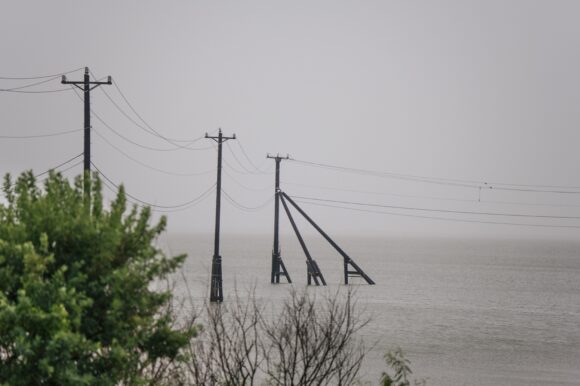Tropical Storm Nicholas is lashing the U.S. Gulf Coast with torrential rain that could last for days, knocking out power, unleashing floods and dealing another blow to the energy industry just two weeks after Hurricane Ida.
The storm made landfall in Texas early Monday morning southwest of Houston with winds of 70 miles (110 kilometers) per hour, the eighth tropical cyclone to hit the U.S. this year. “Life-threatening” flash floods are expected across the South over the next couple of days, the National Hurricane Center said. Power outages shut two critical fuel pipelines to the Northeast and a natural gas export terminal.
“It could be several days of heavy rain across the Gulf coast,” Josh Weiss, a forecaster at the U.S. Weather Prediction Center, said.
By late Tuesday afternoon, the storm’s winds had dropped to 40 mph as it moves into Louisiana, bringing 5 to 10 inches (13 to 25 centimeters) of additional rainfall across the region. There could be isolated totals of 20 inches in southern and central Louisiana and the western Florida Panhandle, the Hurricane Center said.
More than 215,000 homes and businesses were without power Tuesday night in Houston and nearby counties, down from a high of 520,000, according to PowerOutage.US, which tracks utility outages.
The blackouts forced Colonial Pipeline Co. early Tuesday to shut two pipelines, both of which are critical fuel conduits from the U.S. Gulf Coast to the Northeast. Freeport LNG said all three production units at its liquefied natural gas export terminal near Houston were down, likely due to an electricity disruption.
While Nicholas mostly bypassed the Gulf of Mexico’s oil and natural gas platforms, torrential rains pose a threat to coastal refineries and petrochemical facilities. The region’s energy sector is still recovering from the impact of Hurricane Ida more than two weeks ago, with about 40% of the Gulf’s offshore crude capacity offline. Oil futures traded higher Tuesday on speculation Nicholas could add to the disruption to supply.
The heaviest rain will likely fall from Monday to Wednesday, according to the Weather Prediction Center. The storm surge could reach five feet at Galveston Bay in Houston.
The storm’s slow forward advance adds to the flooding risk as it passes over the region.
Nicholas is the Atlantic’s 14th storm in 2021. Half of the storms so far have hit the U.S., and Ida was the season’s worst, crashing into the Louisiana coastline before devastating New York with rain and floods. On Monday, AIR Worldwide updated its projected losses from Ida, saying the storm probably caused $20 billion to $30 billion in insured losses. Earlier estimates were around $18 billion.
Nicholas may also hamper restoration efforts of Gulf of Mexico oil platforms and pipelines that have remained offline since Ida. U.S. Gulf Coast physical crude prices could surge if supplies aren’t returned promptly.
An average Atlantic season produces 14 storms by the time it ends in November, so 2021 is ahead of pace.
–With assistance from Sheela Tobben, Yueqi Yang, Sergio Chapa, Lars Paulsson and Will Wade.
About the photo: Transmission towers are shown ahead of the Tropical Storm Nicholas on September 13, 2021 in Galveston, Texas. Photographer: Brandon Bell/Getty Images
Was this article valuable?
Here are more articles you may enjoy.


 Wall Street Brokers Start Trading Insurer Claims From LA Fires
Wall Street Brokers Start Trading Insurer Claims From LA Fires  Ticketmaster May Have Broken Law With ‘Platinum’ Oasis Seats
Ticketmaster May Have Broken Law With ‘Platinum’ Oasis Seats  Tesla Showroom Strikes, Vandalism Sparked by Fury Against Musk
Tesla Showroom Strikes, Vandalism Sparked by Fury Against Musk  Scammers Are Pushing Auto Loan Fraud to Record Levels
Scammers Are Pushing Auto Loan Fraud to Record Levels 